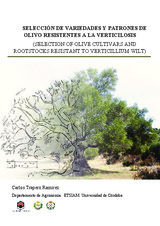Selección de variedades y patrones de olivo resistentes a la verticilosis
Selection of olive cultivars and sootstocks resistant to Verticillium Wilt
Autor
Trapero Ramírez, Carlos
Director/es
Barranco Navero, DiegoLópez Escudero, Francisco Javier
Editor
Universidad de Córdoba, Servicio de PublicacionesFecha
2014Materia
Olivo (Olea europaea)Verticilosis
Verticillium dahliae Kleb
Enfermedades
Evaluación
Resistencia a enfermedades
Programa de mejora
Olive (Olea europaea)
Diseases
Evaluation
Disease resistance
Breeding program
METS:
Mostrar el registro METSPREMIS:
Mostrar el registro PREMISMetadatos
Mostrar el registro completo del ítemResumen
Olive (Olea europaea L.) is the most important non-tropical tree crop
worldwide, and the oil from its fruit is an essential source of food for many
countries. Spain is the first country by cultivated area and the first producer and
exporter of olive oil and table olives in the world. Verticillium wilt of olive caused
by the fungus Verticillium dahliae Kleb. is currently considered the most important
disease affecting this crop. The use of resistant plant material has been demonstrated
the most effective and economical control method in other woody crops affected by
this pathogen. Thus, obtaining Verticillium wilt resistant genotypes is currently a
major aim for the breeding in olive.
The first objective of this thesis was to evaluate the Verticillium wilt
resistance of 11 olive cultivars in two fields naturally infested by the pathogen. Two
years after planting in the heavily infested soil, V. dahliae had killed all trees of
several susceptible cultivars, such as the Spanish main cultivar ‘Picual’, showing up
the elevated risk of planting susceptible cultivars in these soils. No cultivar showed
complete resistance to the disease, although ‘Frantoio', 'Empeltre' and 'Changlot Real'
showed a high level of resistance especially in the moderately infested soil. This
information was useful for the subsequent design for the crosses in the breeding
program.
A second step was to develop a screening method for evaluating large numbers
of genotypes for resistance to V. dahliae. The most effective method was the
inoculation of young seedlings by dipping their roots in a conidial suspension (107
conidia/ml) of a highly virulent isolate of V. dahliae and their further evaluation
under controlled conditions. This inoculation method was then used to screen for
resistance more than 6000 genotypes. These genotypes corresponded to 48 different
progenies and were obtained by open pollination or crosses from olive cultivars, wild
olive genotypes and other wild relatives of the genus Olea. The results suggest that it
is possible to breed for Verticillium wilt resistance in olive, although this resistance
appears to be mostly polygenic. The next step in this is chapter yields information on
the selection of resistant genotypes which will move forward to the next step of the
breeding program, as well as the best genitors and crosses to breed for this character
in olive.
Almost 900 genotypes were selected for their disease resistance and good
growing performance under controlled conditions. Some of them were evaluated in a
field heavily infested with V. dahliae. It was demonstrated that the selection in the
seedling stage, either by root dipping or stem injection is an effective procedure as
the first step for obtaining plant material resistant to the disease. Seventy seven out... El olivo (Olea europaea L.) es el cultivo leñoso no tropical que ocupa mayor
superficie en todo el mundo y su aceite es una fuente de alimentación de gran
importancia en muchos países. España es el país con mayor superficie de olivar del
mundo, así como el primer productor y exportador de aceite de oliva y de aceituna de
mesa. La verticilosis del olivo causada por el hongo Verticillium dahliae Kleb. está
considerada como la enfermedad más importante que afecta a este cultivo
actualmente. El uso de material vegetal resistente ha sido el método más eficaz y
económico para el control de esta enfermedad en otros cultivos leñosos. Por esta
razón, la obtención de genotipos resistentes a la verticilosis es un objetivo prioritario
de la mejora actual del olivo.
El primer objetivo de la presente tesis doctoral fue la evaluación de la
resistencia a la enfermedad de 11 cultivares de olivo en dos fincas infestadas de
forma natural con el patógeno. La muerte de todos los árboles de los cultivares más
susceptibles en un periodo de menos de dos años desde la plantación pone de
manifiesto el riesgo elevado para el cultivo del olivo en este tipo de suelos. Por otra
parte, ningún cultivar mostró una resistencia completa a la enfermedad, aunque
‘Frantoio’, ‘Empeltre’ y ‘Changlot Real’ sí mostraron un nivel elevado de
resistencia. Estos resultados sirvieron para seleccionar los genitores utilizados
posteriormente en los cruzamientos del programa de mejora.
El siguiente objetivo fue la puesta a punto de un método para la evaluación de
un gran número de genotipos y su selección por resistencia a V. dahliae. Éste
consistió en la inoculación de plántulas jóvenes mediante inmersión de las raíces en
una suspensión de conidios (107 conidios/ml) de un aislado altamente virulento de V.
dahliae y posterior evaluación en condiciones controladas. Mediante este
procedimiento se evaluaron más de 6000 genotipos obtenidos mediante polinización
libre o cruzamientos entre cultivares, genotipos de olivo silvestre (acebuche), otras
especies del género Olea y subespecies de O. europaea. Gracias a esa evaluación se
identificaron los mejores genitores y cruzamientos para la obtención de genotipos
resistentes. Los resultados sugieren que la mejora del olivo por resistencia a la
Verticilosis es factible, y que esta resistencia parece ser principalmente de tipo
poligénica. Este capítulo aporta información acerca de la selección de genotipos
resistentes que continuarán en la siguiente fase del programa de mejora, así como de
los mejores genitores y cruzamientos para la mejora de este carácter en olivo.
Unos 900 genotipos se seleccionaron por su resistencia a la enfermedad y su
crecimiento en condiciones controladas. Algunos de ellos se evaluaron
posteriormente en un campo altamente infestado con V. dahliae, donde se comprobó...

